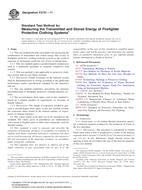Potřebujeme váš souhlas k využití jednotlivých dat, aby se vám mimo jiné mohly ukazovat informace týkající se vašich zájmů. Souhlas udělíte kliknutím na tlačítko „OK“.
ASTM F2731-11
Standard Test Method for Measuring the Transmitted and Stored Energy of Firefighter Protective Clothing Systems
Automaticky přeložený název:
Standardní zkušební metoda pro měření vysílaného a záložní energii hasič ochranný oděv systémy
NORMA vydána dne 1.7.2011
Informace o normě:
Označení normy: ASTM F2731-11
Poznámka: NEPLATNÁ
Datum vydání normy: 1.7.2011
Kód zboží: NS-54448
Počet stran: 13
Přibližná hmotnost: 39 g (0.09 liber)
Země: Americká technická norma
Kategorie: Technické normy ASTM
Kategorie - podobné normy:
Anotace textu normy ASTM F2731-11 :
Keywords:
firefighters, material systems, protective clothing, radiant heat, transmitted energy, second-degree burn injury, stored energy, Protective clothing, Radiant energy, Radiant heat exposure/testing, Firefighter--protective clothing, Radiant protective performance, Thermal protective clothing, ICS Number Code 13.340.10 (Protective clothing)
Doplňující informace
| Significance and Use | ||||||||||||||
|
Firefighters are routinely exposed to radiant heat in the course of their fireground activities. In some cases, firefighters have reported burn injuries under clothing where there is no evidence of damage to the exterior or interior layers of the firefighter protective clothing. Low levels of transmitted radiant energy alone or a combination of the transmitted radiant energy and stored energy released through compression can be sufficient to cause these types of injuries. This test method was designed to measure both the transmitted and stored energy in firefighter protective clothing material systems under a specific set of laboratory exposure conditions. The intensity of radiant heat exposure used in this test method was chosen to be an approximate midpoint representative of ordinary fireground conditions as defined for structural firefighting (1), (2) . The specific radiant heat exposure was selected at 8.5 ± 0.5 kW/m2 (0.20 ± 0.012 cal/cm2-s) since this level of radiant heat can be maintained by the test equipment and produces little or no damage to most NFPA 1971 compliant protective clothing systems. 5.2.1 Discussion—Utech defined ordinary fireground conditions as having air temperatures ranging from 60 to 300°C and having heat flux values ranging from 2.1 to 21.0 kW/m2 (0.05 to 0.5 cal/cm2-s). Protective clothing systems include the materials used in the composite structure. These include the outer shell, moisture barrier, and thermal barrier. It is possible they will also include other materials used on firefighter protective clothing such as reinforcement layers, seams, pockets, flaps, hook and loop, straps, or reflective trim. The transmission and storage of heat energy in firefighter protective clothing is affected by several factors. These include the effects of “wear” and “use” conditions of the protective clothing system. In this test method, conditioning procedures are provided for the laundering of composite samples prior to testing, and also composite sample moisture preconditioning. The amount of moisture added during preconditioning typically falls into a worst case amount in terms of predicted heat transfer, as suggested by Barker (3). Two different procedures for conducting the test are provided in this test method. Procedure A involves an iterative approach to determine the minimum exposure time followed by a fixed 60-second compression time required to predict a second degree burn injury. In this approach, the length of the radiant exposure is varied systematically using a series of tests to determine the length of the radiant exposure that will result in the prediction of a second degree burn injury. Procedure B involves using a fixed radiant heat exposure time to determine if a second degree burn injury will or will not be predicted. If a second degree burn injury is predicted, the time to a second degree burn injury is reported. If a second degree burn injury is not predicted, the result is indicated as “no predicted burn.” Procedure B involves a fewer number of tests. This procedure includes recommended fixed radiant exposure times. |
||||||||||||||
| 1. Scope | ||||||||||||||
|
1.1 This test method provides procedures for measuring the combination of transmitted and stored energy that occurs in firefighter protective clothing material systems as the result of exposure to prolonged, relatively low levels of radiant heat. 1.1.1 This test method applies a predetermined compressive load to a preheated specimen to simulate conductive heat transfer. 1.1.2 This test method is not applicable to protective clothing systems that are not flame resistant. 1.1.3 Discussion—Flame resistance of the material system shall be determined prior to testing according to the applicable performance and/or specification standard for the material’s end-use. 1.2 This test method establishes procedures for moisture preconditioning of firefighter protective clothing material systems. 1.3 The second-degree burn injury used in this standard is based on a limited number of experiments on forearms of human subjects. 1.3.1 Discussion—The length of exposures needed to generate a second-degree burn injury in this test method exceeds the exposures times found in the limited number of experiments on human forearms. 1.4 The values stated in SI units are to be regarded as the standard. The values given in parentheses are mathematical conversions to English units or other units commonly used for thermal testing. 1.5 This standard is used to measure and describe the properties of materials, products, or assemblies in response to radiant heat under controlled laboratory conditions but does not by itself incorporate all factors required for fire-hazard or fire-risk assessment of the materials, products, or assemblies under actual fire conditions. 1.6 This standard does not purport to address all of the safety concerns, if any, associated with its use. It is the responsibility of the user of this standard to establish appropriate safety and health practices and determine the applicability of regulatory limitations prior to use. Specific precautionary information is found in Section 7. |
||||||||||||||
| 2. Referenced Documents | ||||||||||||||
|
Doporučujeme:
Aktualizace zákonů
Chcete mít jistotu o platnosti užívaných předpisů?
Nabízíme Vám řešení, abyste mohli používat stále platné (aktuální) legislativní předpisy.
Chcete vědět více informací? Podívejte se na tuto stránku.




 Cookies
Cookies
